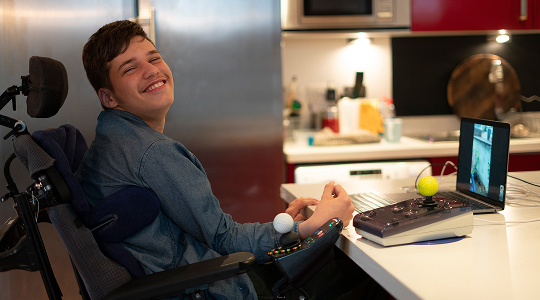You can enrol in up to 20 courses during temporary access. You’ve reached this limit and can’t enrol in any more right now.
Once you have full access, you’ll be able to enrol without limit.
Jay’s healthcare professional: Dietitian for Paediatrics and Adults, Royal National Orthopaedic Hospital


![]()
Jay is a 14-year-old male who sustained a traumatic spinal cord injury, following an accidental fall in a school playground, where another child fell on him. Initially getting up and walking away from the incident, he collapsed 24 hours later and was admitted to hospital.
The injury had restricted blood flow to the spinal cord. Jay was now tetraplegic (C3 ASI C incomplete spinal cord injury) and unable to breathe without full use of a ventilator, he had a tracheostomy and relied entirely on nasogastric feeding to meet his nutrition and hydration needs. The nasogastric tube was adding to the challenges of managing his secretions, and after one month this was replaced by a percutaneous endoscopic gastrostomy (PEG). Jay was transferred to the Royal National Orthopaedic Hospital, a tertiary centre offering specialist spinal rehabilitation.
Prior to the accident, Jay was a healthy, athletic young person, tall for his age measuring 1.88 m in height. An avid swimmer, he had a muscular build and a weight of 75 kg.
![]()
By the time he arrived for rehabilitation, Jay had experienced significant weight loss post-injury, with a body weight of 48.5 kg. Initial rehabilitation goals were to attempt to wean him off the ventilator, and regain body weight. Jay experienced intense neuropathic pain so severe that sedation was required to handle the PEG tube.
Jay’s Dietitian started him on PaediaSure Plus Fibre upon arrival, with six daytime bolus feeds, which he tolerated very well. His body size might have indicated the use of an adult feed however the protein level was potentially excessive and was found previously to adversely affect his kidney function. He was transitioned to a continuous feeding regime of PaediaSure Plus Fibre overnight, in combination with two PaediaSure Compact* boluses during the day, adding a further 600 kcal/day to support recovery. PaediaSure Compact was selected due to its low-volume presentation which reduced pressure from the stomach on Jay’s lungs, supporting respiratory weaning. Jay tolerated his enteral feeding regime well.
Once weaned off the ventilator when Jay was able to swallow safely, oral feeding was introduced at IDDSI 6 texture-modified diet. PaediaSure Compact was delivered via the PEG tube to support his nutrition while being established on food. Re-establishing a fully oral diet and allowing all textures and free fluids took over a month - being limited by fatigue and an overall low psychological status.
As Jay’s abdominal sensitivity and neuropathic pain were negatively impacting and decelerating rehabilitation potential, the decision was made to remove the PEG prematurely. This created a notable psychological improvement, pain (both physical and psychological in origin) diminished, which allowed hoisting and acceptance of the wheelchair.
The high-fibre content of PaediaSure Plus Fibre helped to optimise Jay’s bowel management. Once the PEG tube was removed, he was reliant on oral intake to meet his nutritional and hydration needs. While having PaediaSure Compact, no supplementary vitamins and minerals were required.
6 months after his accident, Jay was enjoying eating and drinking normally, breathing unsupported day and night, able to use a powered wheelchair and manipulate a computer screen unaided. He was discharged home and started reintegrating back into his former mainstream school. Jay had successfully regained weight to an ideal 71.6 kg, and his pressure sores had healed.
![]()

Learn more about Lucy and her health challenges.

Learn more about Lucas and his health challenges.

Learn more about Rebecca and her health challenges.
Footnotes:
*The PaediaSure range is for ages 1-10 years or children weighing 8-30kg. The use of PaediaSure medical nutrition products outside of these ranges is under the supervision of the healthcare professional and their clinical judgement.
SESSION TIMEOUT
Please log in to continue
Thanks for registering. To begin, please log in to your ProConnect account. After you log in, you’ll have temporary access to all resources and education while we verify your details.
Added to Bag
ENSURE PLUS
1 x 220 ml
Flavor: Apple
1,5 kcal / ml
Nutrition Information
| Unit | Per {ml-col-1} ml | Per {ml-col-2} ml |
| Unit | Per {ml-col-1} ml | Per {ml-col-2} ml |
| Unit | Per {ml-col-1} ml | Per {ml-col-2} ml |
footnotes
Product details not available.
You have {liteUserDaysLeft} business days of temporary access.
Based on your email address {email} your account has not yet been approved. We’re validating your credentials. You won’t be able to order samples until your account is approved and activated. Please check your email for more details. For help, contact us at abbott.proconnect_access@nhs.net.
UK--2500192 | September 2025
You have {liteUserDaysLeft} business days of temporary access.
Based on your email address {email} your credentials are validated but not yet activated. To gain full access, including the ability to order samples, click the activation link we sent to your inbox. For help, contact us at abbott.proconnect_access@nhs.net.
UK--2500192 | September 2025
Register to continue reading this article
UK-N/A-2400058(v9) | September 2025
You are about to exit for another Abbott country or region specific website.
Please be aware that the website you have requested is intended for the residents of a particular country or region, as noted on that site. As a result, the site may contain information on pharmaceuticals, medical devices and other products or uses of those products that are not approved in other countries or regions.
The website you have requested also may not be optimised for your specific screen size.
Do you wish to continue and exit this website?
UK-N/A-2200465 | July 2022
This website is for UK HCPs and UK Patients only. If you are outside of the UK please visit our global website Abbott.com
If you choose "I am a patient/carer”, you will be entering a website intended for patients and carers which has information on Abbott products. Products on this website are to be used under medical supervision. If you have questions about the product information discussed on this website, you should consult with your healthcare professional.